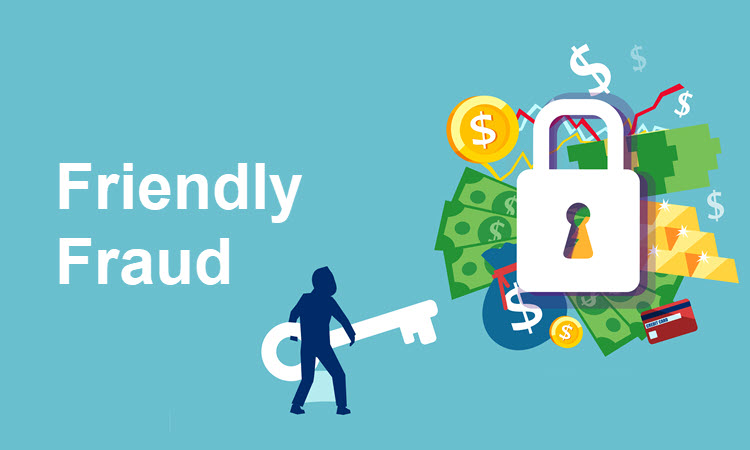Payment fraud affects merchants in all industries. With the expansion of ecommerce and the emergence of new opportunities for processing card-not-present transactions, there has been a rapid rise of fraud attempts.
One of the common types of payment fraud is friendly fraud. Analysts speculate that this type of fraud accounts for about one-third of all disputed transactions. Friendly fraud is difficult to track and predict, and it can cause a lot of damage to the merchant’s finances and reputation, including jeopardizing their merchant account.
This article explains how friendly fraud works, how to recognize it, and what merchants need to do to prevent friendly fraud from hurting their business.
What Is Friendly Fraud?

Friendly fraud is a type of payment fraud which involves legitimate customers buying a product with their credit or debit card and then requesting a chargeback from their card issuing institution.
It is different from true fraud as legitimate cardholders are the ones who initiate the transaction rather than identity thieves, who steal card information and commit payment fraud.
How Does It Happen?
Friendly fraud happens when a customer pays for a product and then disputes the transaction, claiming it was unauthorized. It can happen intentionally, because the cardholder wishes to get a product or service for free or by accident when the cardholder genuinely doesn’t recognize or remember the purchase.
An example of “honest” friendly fraud is when children make in-app purchases on their parents’ smartphones without their parents’ knowledge and consent. That’s why the video and gaming industries experience a high rate of friendly fraud.
Card issuing companies usually approve chargeback requests because of consumer protection laws. In those cases, merchants need to cover the reimbursed transaction costs, along with additional chargeback processing fees.
How to Know When a Chargeback Is Friendly Fraud?
It is difficult to distinguish a genuine chargeback request from friendly fraud because customers cite the same reasons for disputing a transaction:
- They didn’t authorize the transaction.
- They didn’t receive the purchased goods.
- They received goods of lower quality than marketed.
- They were charged more than they expected.
What Are the Consequences of Friendly Fraud?
Depending on the circumstances, persistent friendly fraud can have serious repercussions for merchants and customers.
Consequences For Merchants
- Merchant account status. Payment processors, banks, and card brands want to avoid chargebacks and refunds. Merchants with a high chargeback rate may be denied the option to accept card payments or even have their merchant account closed altogether.
- Customer experience. Because it is challenging to differentiate between friendly and genuine fraud, customers may feel they have not been treated fairly and may refrain from future payments.
- Chargeback and refund fees. Merchants may be required to pay additional processing fees.
- Lower revenue. Besides returning the funds to the customer, paying additional fees, and the tarnished reputation, merchants may never recover the tangible item, product, or service they already provided to the customer.
Consequences For Customers
- Loss of trust. Customers treat chargeback disputes seriously and with apprehension. They are likely to stop buying from the merchant they had an issue with, regardless of how well the merchant handled the matter.
- Blacklists. Merchants and processors keep track of chargeback requests. If a customer acts suspiciously or if it is clear they did not make an earnest mistake, future payments are restricted. Customers may find that they are unable to pay on certain websites due to suspected fraud.
- Reduced banking privileges. Banks also keep track of customer behavior and may inflict certain penalties in cases they determine were a consequence of fraud. This may hurt the client’s overall credit score or lead to the closure of the client’s bank account.
How to Prevent Friendly Fraud?

Fraud prevention is easier than proving to a card issuing company that a chargeback request is friendly fraud.
To decrease fraud-related losses, implement the following fraud prevention best practices.
- Ensure your company name matches the descriptor on customers’ bank statements. Friendly fraud often results from a discrepancy in your company name and the statement descriptor. In such cases, consumers don’t recognize the charge and dispute it thinking it’s not a transaction they had approved.
- Invest in reliable 24/7 customer service. A helpful and always available customer service helps ensure that the transaction dispute is settled between the merchant and the customer without involving the cardholder’s issuing bank and accruing transaction dispute processing fees.
- Clearly communicate all product or service charges to your customers. If customers discover hidden costs connected to their purchase, they are more likely to request a chargeback. Be upfront about shipping fees and other fees that go into the final price. Inform customers about shipping and delivery dates, potential delivery delays, and other relevant information to make the customer’s shopping experience fully transparent.
- Clearly describe your product and/or service. It’s important to set realistic expectations about your service or product. You don’t want to fraud a victim, and the same goes for consumers. If they feel dissatisfied or tricked, consumers will insist on getting a chargeback.
- Implement a clear refund policy. If the customer is unhappy with the product or service, incentivize them to request a refund directly from your company rather than request a chargeback from the card-issuing company.
- Send reminders for recurring payments. Sometimes customers don’t remember they signed up for a subscription. Send email reminders about upcoming charges to prevent chargeback requests.
- Keep records of all transactions for at least 180 days. Friendly fraudsters sometimes take a long time to request a chargeback. To dispute a false chargeback request, gather all evidence that the transaction was authorized, including email and phone correspondence, signed product delivery papers, the customer’s IP address, date and time of the purchase, etc.
- Keep a blacklist of customers who repeatedly request chargebacks. Evidence suggests that the ease of acquiring a chargeback from a bank compels customers to repeat the fraud. Keep a list of customers who requested chargebacks and deny purchases to those who repeat them.
Note: A high number of chargebacks can be determinal for the merchant. The number of chargebacks against a merchant determines the merchant’s chargeback rate. To learn more about chargeback rate read our article and find out what is it, how to calculate it and what is a normal chargeback rate
Conclusion
Whether accidental or intentional, friendly fraud causes serious damage to businesses. Apart from losing money, merchants spend time providing evidence for chargeback disputes and risk losing their merchant accounts or falling into a high-risk merchant category.
To minimize the risk, merchants need to implement a combination of best fraud prevention practices and continually work with their payment processor in fortifying their fraud prevention strategies.
